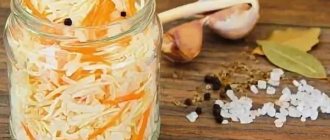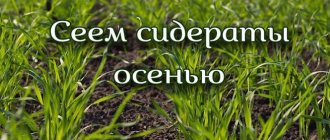Green manure plants are called green manure.
Using them in growing vegetables is a more labor-intensive process than using mineral fertilizer compounds. But if green manure is sown in the fall before winter 2022, then before the next season they will not only enrich the soil with organic matter and minerals in a form accessible to plants, but will also improve the quality of the soil. Dear readers! For you, we have created communities on social networks in which useful articles and interesting ideas are published several times a day! Subscribe and receive useful content in a convenient format!
Popular types of green manure
For green manure, only plants with a short growing season, capable of quickly growing green mass and being easy to care for, are used. Most popular:
- Legumes (beans, sainfoin, soybeans, lentils, seradella, peas, chickpeas, alfalfa, sweet clover, spring vetch, clover, annual lupine). They loosen the soil, enrich it with nitrogen, suppress the growth of weeds, are frost-resistant, and repel nematodes.
- Hydrophiles. Phacelia saturates the soil with oxygen, nitrogen, minerals, protects against weeds and harmful bacteria.
- Cruciferous vegetables (oilseed radish, mustard, rapeseed, rapeseed). They loosen the soil well, are frost-resistant, grow quickly, protect against diseases, and repel wireworms and nematodes. They convert phosphorus and sulfur into accessible compounds for cultivated plants. Attracts bees. But they cannot be planted in acidic soil and before cabbage, after potatoes and tomatoes.
- Cereals (oats, rye, barley, wheat, millet). Saturate the soil with potassium and nitrogen. Prevents weeds from growing. Improves soil quality.
- Buckwheat. Buckwheat loosens the soil, enriches it with phosphorus and potassium.
- Compositae (calendula, sunflower). They grow on any soil, loosen it, repel aphids, bugs, midges, caterpillars and attract bees.
What to do if the mustard has outgrown
The concept of “outgrown” is very vague. If the mustard has just bloomed and the first green pods have appeared, then all is not lost. It can also be mowed, chopped and incorporated into the soil. This mass will take a little longer to rot and decompose. Or leave the tops as mulch.
It’s another matter if the mustard has grown, ripened and began to dry (or has already dried). In this case, there is no particular need to smell the mustard. The plant gave micro and macroelements to its offspring - its seeds. The stems have become coarser, the leaves by this time are already yellow or dry. Therefore, it is easier to either burn these weeds to obtain ash, or take them to the compost heap. There is no point in smelling it anymore. The roots will already rot, and the above-ground mass is no longer as interesting as young greenery.
You also need to be prepared for the fact that after heavy rainfall, the spilled seeds will begin to sprout and a second generation of mustard will grow in your garden.
When to plant green manure in the fall to improve the soil: planting dates
Green manure plants can be planted immediately after the bed is free - from August to October. While the ground is still warm, they manage to grow up to 40 cm above the ground and up to 30 cm below it. By spring, the dead plants will decompose and give up all their useful substances to the earth. When planting green manure, it is important to prevent them from fully ripening by mowing them at a height of 20-30 cm during the budding period.
On a note!
Planting dates depend on the cold resistance of the plant. Mustard, rapeseed and winter rye are planted in August, and oats in September.
Plant fertilizer for cucumbers
Cucumbers extract all the beneficial substances from the top layer of soil. For their growth and fertility, it is necessary to compensate for these losses. Rapeseed, vetch, peas, barley, phacelia, and oats are suitable for this. You can sow them in the usual way. It is also effective to do this in the summer, when the crop bears fruit. Scatter the seeds between the rows. You will receive a rich harvest and healthy plants.
It is not advisable to grow rye before cucumbers.
It is not advisable to grow rye in front of cucumbers. It fights weeds well and suppresses cucumbers. They grow worse and produce noticeably smaller yields.
What green manure to sow in the garden in the fall
Before choosing green manure for sowing before winter, you need to decide what you plan to plant in this bed in the spring. There is no universal plant that can be used for any crop:
- For strawberries - rapeseed, buckwheat, Shrovetide radish or mustard.
- For potatoes – peas, oats or white mustard.
- Under cucumbers - carrots or beets.
- Turnips or cabbage are planted under radishes.
Winter vetch is often sown with cereals under cabbage. She:
- Suitable for heavy soil, protects it from weathering and washing out.
- Does not grow well in acidic and dry soils.
- Suppresses the growth of weeds.
- Enriches the soil with nitrogen compounds, repels snails and slugs.
White mustard (planted under potatoes) is not afraid of cold weather, and also:
- protects beds from freezing;
- enriches the soil with sulfur, phosphorus, organic matter and loosens it;
- suppresses the growth of weeds and pathogenic organisms;
- repels nematodes, slugs, moths and wireworms.
On a note!
The sowing rate is 3-4 g/m², to combat wireworms – up to 10 g/m².
Winter rye grows on any soil. She:
- frost-resistant, enriches the soil with nitrogen, potassium and organic compounds, improves its moisture and air permeability;
- protects the soil from erosion, weeds, fungal pathogens and root nematodes;
- quickly produces green mass;
- suitable for planting under tomatoes, potatoes, zucchini, cucumbers, pumpkin;
- has a sowing rate of 900 g per 100 m².
Oats grow on any soil. Main features:
- can be combined with rye, peas, lupine or vetch;
- improves clay soil, loosens and enriches it with phosphorus, potassium and organic matter;
- suppresses weed growth, protects against root rot and fungal diseases;
- suitable for planting under cucumbers;
- sowing rate – 10-15 g/m².
Bottom line
In winter, it is much more convenient to sow green manure on land prepared after harvesting; there is no need to mow it before the onset of frost; nutrients slowly enter the soil as the green mass decomposes.
Even if winter green manure did not have time to gain green mass before the onset of cold weather, it will grow in early spring. The slow decomposition of organic matter during the winter constantly enriches the soil with nutrients; by spring, high-quality humus is formed in the soil.
In addition to enriching the fertile layer with nutrients, winter green manure restores soil structure and loosens heavy soils well. They also contribute to the formation of a natural drainage system, adjusting water balance and air exchange.
Thanks to their developed root system, green manure plants keep the surface layer of soil from being washed away by spring waters. In areas with planted winter green manure, fewer weeds appear, and the ground is protected from freezing and weathering.
However, before planting seeds, it is necessary to clarify the suitability of the soil composition for the development of green manure crops, since some plant species are intolerant to acidified or waterlogged soils.
Features of sowing green manure in a greenhouse
Over time, the soil in a greenhouse becomes almost unsuitable for growing plants due to mineralization and the accumulation of harmful microorganisms and pests. It is worth changing the soil periodically. But there is a way out of this situation - sowing green fertilizer, because:
- It's economical. You will have to spend more money on purchasing organic fertilizers.
- There is no risk of introducing weeds. They mainly come in with manure and humus.
- No need to fight pests and diseases.
- No need to loosen the soil. The roots of the plants will do this.
On a note!
It is better to sow green fertilizers in a greenhouse twice - in September and November. But these must be different plants.
Sown green manure plants will have time to sprout before frost in September. They can be left until spring, and before planting the main crop, remove from the surface what has not rotted. November plantings will emerge in the spring. They will need to be pruned before flowering and also removed before re-sowing.
You need to choose a variety for a specific place in the greenhouse, focusing on the crop that you plan to plant after it. Good results are obtained by alternating green manure in a greenhouse: in the first season, sow rye, in the second - mustard, in the third - beans, phacelia or peas. As a result, the quality of the soil will radically improve.
Is it possible to plant tomatoes after mustard? After which crop is it better to plant garlic for the winter?
So, let's look at which crops you can plant winter garlic after. Any of the crops we grow on our plot takes from the ground the necessary and calorie substances it requires. After a set period of time, the reserves of the land begin to dry up, and before planting a new crop, it is necessary to plant plants that will restore the fertility of the land as a basis. This process is called fruiting. Thanks to it, absolute depletion of soil reserves is prevented.
Almost all gardeners know that growing one crop in one place every year is not recommended. This rule also applies to garlic. A rare case are potatoes, strawberries, beans, and tomatoes.
Since garlic has a short root system, it is better to grow crops with long roots in front of it. With such a root system, when growing, it greatly depletes the outer layer of soil. And if you are going to plant something in front of the garlic, then directly those plants that will get food from the deepest layers.
It is useful to introduce basic fertilizers during the period of growing predecessors, since in the autumn before planting garlic their use may be unnecessary.
After what can you plant garlic? Cereal crops (besides oats and barley) are considered the best predecessors for garlic, because they, like excellent green manure, increase the quality of the land. In addition, forage grasses such as clover and alfalfa, as well as squash and zucchini, are also excellent predecessors. If berry fields were previously grown in the selected area, then garlic can be planted after them.
With a certain stretch, those vegetables that are demanding of nitrogen are suitable as predecessors of winter garlic: cabbage, tomato, pumpkin, cucumber and pepper.
We are often asked, is it possible to plant garlic after peas? Yes! This is one of the best predecessors. What else could they be:
- green manure grain crops (besides oats and barley);
- forage grasses (alfalfa, clover);
- legumes (beans, peas). ;
- squash;
- zucchini;
- pumpkin;
- berry plants;
- early cabbage, cauliflower;
- cucumbers
Valid predecessors:
- cabbage of medium, late types;
- tomato;
- pepper;
- eggplant.
Is it possible to plant garlic after mustard? Mustard works great for planting winter garlic. Sowing is carried out in July-August in areas free from main crops. In 2 months in the garden, mustard manages to accumulate a whole volume of green mass, which is plowed directly into the soil using a flat cutter or digging. Planting of greenery is carried out before flowering begins. Start planting winter types of garlic, both bulbs and cloves, possibly 3 weeks after plowing.
In addition, spring varieties can be planted in beds after mustard; the main requirement is that the green manure crop must be planted in the autumn, so that by the time the cloves are planted in early spring, the biomass has time to completely decompose. Mustard enriches the soil with essential nitrogen, phosphorus, and a complex of microelements, to which garlic is very demanding.
How to sow green manure correctly
Green manure is planted in loose and moist soil. It is best to sprinkle them with a little soil or mulch. This will improve the germination of seeds and protect them from birds. You cannot use green manure from the same family as the plants for the next planting. Their diseases and pests are the same. In spring, it is best not to dig up the ground with the remaining plants, but to cut off the above-ground part. Then mulch or compost it. You should not sow the same green manure every year.
On a note!
To speed up the decomposition of the remaining green manure plant parts in the ground, agronomists recommend watering the soil with preparations containing bacteria (“Shine”).
Green manure is an effective and environmentally friendly fertilizer. It simultaneously nourishes, improves the quality of the soil and protects it from diseases, weeds, pests and adverse weather conditions. Plants that are resistant to cold and temperature changes and have a powerful root system for loosening the soil are suitable for autumn planting in garden beds. They are able to quickly grow green mass. These are mainly representatives of the Cruciferous, Grain and Legume families.
Conclusion
Green plants are an easy and inexpensive way to improve your soil and add extra nutrients to it. By planting them, you can significantly increase the fertility of the garden bed and use it almost without interruption.
Related Materials:
To bury green manure or not, expert advice- When to sow white mustard on green manure
Green manures and their role in agriculture
When to plant green manure to get the maximum benefit from growing them











